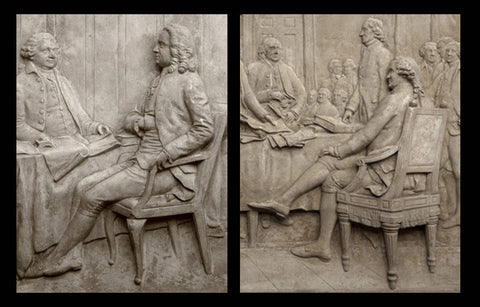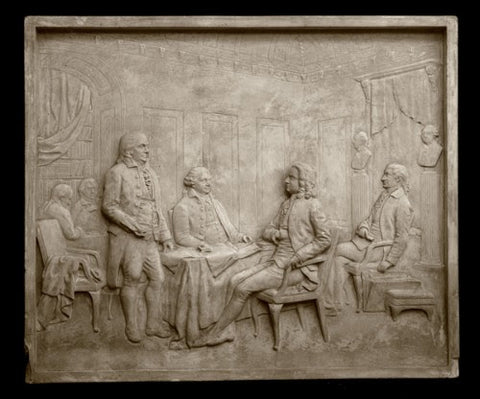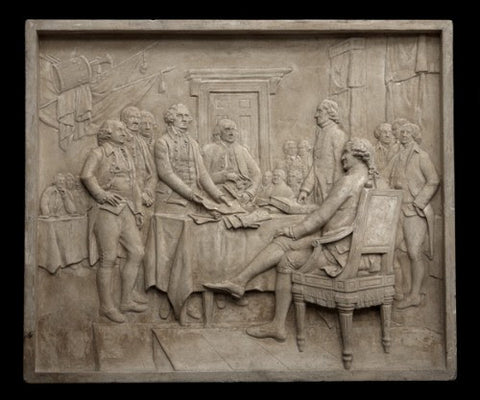In the spirit of President’s Day in the United States and Lincoln’s and Washington’s birthdays, we were planning on talking about the presidential busts in our collection. However, as we were looking through the collection, we spotted and became fascinated with the lesser-known reliefs we have of two significant moments in American history that do in fact include a couple of early presidents:
The Treaty of Peace and Independence, Sept. 3, 1783 - Item #789
The Declaration of Independence, July 4, 1776 - Item #787
Thomas Ball (1819-1911) created two bronze reliefs for the pedestal of Richard Saltonstall Greenough’s (1819-1904) statue of Benjamin Franklin located in front of Boston’s Old City Hall. Greenough created two more reliefs in order to adorn all four sides.
The Two Great Works
Ball, perhaps best remembered for his equestrian sculpture of George Washington in the Boston Public Garden, designed with Greenough The Treaty of Peace and Independence, Sept. 3, 1783 to depict Franklin at the signing of the Treaty (more commonly known as the Treaty of Paris) that ended the Revolutionary War. Although confirmation of those depicted in the relief is elusive, based on appearance the figure standing is likely Franklin and the person sitting at his side is likely John Adams, the second President of the United States. (Note that the luxurious room is even adorned with two busts!)
The second relief is The Declaration of Independence, July 4, 1776 based on John Trumbull’s (1756-1843) painting of the same name. Ball decided to spotlight the right half of the painting that shows John Hancock, president of the Congress, receiving the Declaration from its main author and future President of the United States, Thomas Jefferson. John Adams is the figure on the far left of the central group while Benjamin Franklin is seen on Jefferson’s left.
A Masterful Pairing
Ball and Greenough’s original work The Treaty certainly pairs well with their relief of The Declaration based on Trumbull’s painting. Besides the subject matter influencing the design of The Treaty, Ball and Greenough appear to have also been influenced by The Declaration; they, too, decided to show one man seated at an angle in high relief – even facing in the same general direction as in Trumbull’s work.

Furthering the pairing is of course Ball’s style and the outcome of his use of similar techniques to create the two pieces. For instance, to make the rooms in both plaques appear large and of the same scale, Ball sculpted the room details and men in the background in shallow relief and the men in the foreground in higher relief with the seated man in the highest relief. The relief designs and techniques used make Ball’s two American plaques great complementary pieces.
Go ahead and brush up on your American history this week as we have and enjoy the many artworks that have immortalized it.
Best,
Kayla
Curator of the Caproni Collection
P.S. For those of you interested in a great presidential portrait, we offer several sculptures of Abraham Lincoln, four busts of George Washington, and busts of Ulysses S. Grant, Thomas Jefferson, and Theodore Roosevelt.
Want content like this delivered to your inbox? Sign up for our newsletter!



